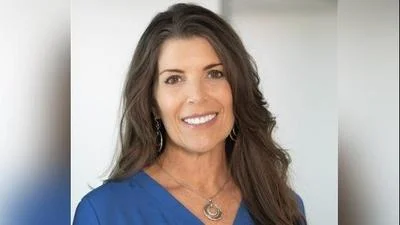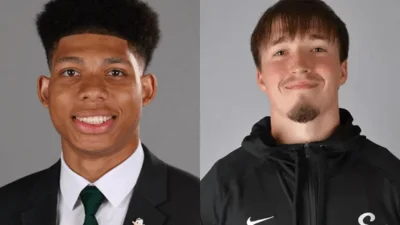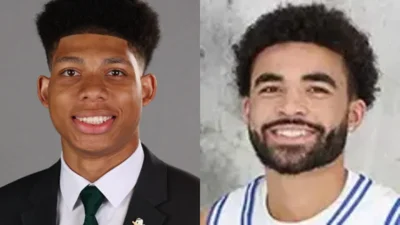Announcement | Announcement
Announcement | Announcement
Senior Luis Schneegans (left) and Junior Zahria Patrick were among the nearly 300 students from across the country to present their work Feb. 9-11 at the Emerging Researchers National Conference in STEM in Washington, D.C. The pair both presented posters about their research – Patrick in the Chemistry and Chemical Sciences category and Schneegans in the Data Science, Convergence Science, Mathematics category. Patrick was awarded second place in her category. (Photo by August Jennewein)
Zahria Patrick had thoroughly prepared for her presentation at the 2023 Emerging Researchers National Conference in STEM. But once the judges approached her, she started to get nervous and spoke slightly longer than she intended.
“I was like, ‘Oh my gosh, it was over five minutes,’” she recalled. “I was panicking.”
However, the University of Missouri–St. Louis junior had nothing to worry about despite those initial doubts. The judges awarded Patrick’s poster presentation second place in the Undergraduate Chemistry and Chemical Sciences category.
“It felt very surreal because I was looking at the list of people in that area, and everybody’s research looked so good, everybody’s posters looked so good,” Patrick said. “I was very surprised because I felt like they were going to critique really, really tough.”
Patrick, a chemistry major, and Luis Schneegans, a senior mathematics major, were among the nearly 300 students from across the country to present their work Feb. 9-11 at the Emerging Researchers National Conference in STEM in Washington, D.C.
The three-day event included undergraduate and graduate student poster and oral presentations, breakout sessions featuring STEM professionals, career-preparation workshops and networking opportunities with employers and graduate school programs.
The annual conference is hosted by the American Association for the Advancement of Science and the National Science Foundation Division of Human Resource Development and is primarily aimed at college students who participate in NSF programs designed to increase the participation of students in STEM fields from underrepresented groups in those disciplines.
Patrick and Schneegans took advantage of the opportunity to attend the conference as Missouri Louis Stokes Alliance for Minority Participation scholars. They each received travel awards from the AAAS, which covered the costs of the registration fee, airfare and housing.
Patrick didn’t expect to receive the funding, but she was thrilled to be selected.
“There are so many applicants, and I thought, ‘This is my very first research project. I don’t know if this is going to be good enough,’” she said. “But they chose me, so I was happy and excited.”
Schneegans had similar reservations because the criteria for mathematics and statistics projects can be very specific. He wasn’t sure if his project would meet those standards, but his efforts were enough to stand out.
Two UMSL faculty members were certain that the pair would be noticed, though.
Jamillah Boyd, an assistant teaching professor of information systems and technology in the College of Business Administration, and E. Paulette Isaac-Savage, professor of adult education in the College of Education, knew that Patrick and Schneegans had participated in NSF Research Experiences for Undergraduates last summer and encouraged both to apply to the conference through MOLSAMP.
Schneegans had also previously attended a mathematics conference, which inspired him to seek similar opportunities.
“I wanted to be able to do a conference that I was able to present my research in, as opposed to just be able to be an attendee there,” he said.
His presentation, “Total Variation Flow in R^n Dimensions with Examples Relating to Perimeters of Level Sets,” focused on research he conducted in Kansas State University’s SUMaR program with Professor Marianne Korten. The project examined an equation to minimize total variation flow, which can be used in image denoising.
“We were successfully able to prove the equation for multidimensions,” Schneegans said.
Patrick’s presentation, “The Effect of Variation of N-Substituents on Oxidopyridinium Ions in (4+3) Cycloadditions,” centered on research she worked on with Rabjohn Distinguished Professor of Chemistry Michael Harmata during the Stevens’ Summer Research Fellowship at the University of Missouri–Columbia.
That project concerned natural product synthesis – a process to synthetically make chemicals that already exist in nature – and Patrick tested whether two chemicals could be used to viably produce a third target chemical.
“With the two chemicals that we tested, one of them gave us great results, and we were able to produce the target chemical in high amounts,” she said.
At the conclusion of their respective REUs, Patrick and Schneegans both had to present their research, but it was a far different experience than the conference. Schneegans noted that he made a 20-minute presentation for his summer research project, but at the conference, the students had to talk with conference-goers and judges for about two and a half hours.
The pair both presented posters – Patrick in the Chemistry and Chemical Sciences category and Schneegans in the Data Science, Convergence Science, Mathematics category – at assigned tables and each had five minutes to walk judges through their project.
On the floor, they stayed sharp by regularly reviewing their posters and research notes from the summer. Schneegans said his conversation with the judges was less demanding than he anticipated, but other attendees were willing to test his knowledge.
“I had another person who wasn’t even a judge, who knew the field very well, and he was asking me tough questions, stopping me every 15 seconds to ask a question,” he said. “It’s just funny to think that my hardest questions didn’t even come from a judge. They came from somebody that was a professor from a different school.”
In addition to the opportunity to share their research, Patrick and Schneegans also enjoyed networking with other STEM students and exploring Washington. Schneegans took advantage of the graduate school fair, where some schools were offering application fee waivers. Patrick took time to tour the venerable cultural institutions of the nation’s capital, including the Lincoln Memorial; the Martin Luther King, Jr. Memorial; the National Museum of African American History and Culture; and the Washington Monument.
“Everything was such a new experience, getting on a plane, going to the conference in Washington, D.C.,” she said. “I kind of just enjoyed taking everything in, speaking with some people from different schools and hearing their research projects, going through the different monuments and museums in Washington. It was like a breath of fresh air because I never really traveled before.”
Schneegans encourages all UMSL students to explore their options to take part in research, which can lead to opportunities like the Emerging Researchers National Conference in STEM: “If anyone’s interested in research, REUs are definitely an option.”
Original source can be found here.




 Alerts Sign-up
Alerts Sign-up